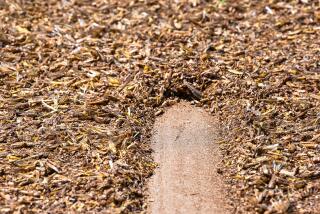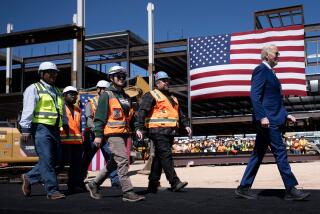Arizona Ranching: Rosy Past, Hazy Future
- Share via
TUCSON, Ariz. — At one time, having cattle translated into economic good times for ranchers like Bob Prosser.
“Take the 1950s, where 10 calves would buy a new pickup,” said Prosser, a fourth-generation rancher. “Now it’ll take 100.”
A host of factors is blamed for the change in cattlemen’s fortunes. Increased operating costs, uncertain beef prices--though they have improved of late--greater environmental pressures on their use of land and greater demand for it all played a role.
It’s gotten to where it’s more profitable for some to sell their land than to raise cattle.
“The opportunity to pay for the land or, if you will, the grass, with the livestock was probably easier done some time ago,” said Prosser, who runs his cattle on more than 300,000 acres of private and public lands between Winslow and Happy Jack in northern Arizona.
The beginning was much different. Cattle ranchers were among Arizona’s first permanent settlers, running their herds on a patchwork of private and public lands as they helped define the region.
The cattle industry quickly became an economic linchpin during territorial days and remained so-- along with copper, cotton and citrus --as Arizona achieved statehood early this century.
“When my family showed up in 1880, ranching, along with the mines and the railroad, was the economy of Arizona,” said Interior Secretary Bruce Babbitt, a third- generation member of a pioneering Arizona family.
“The real problem [now] is that raising cattle on desert lands is no longer profitable because cattle production has accelerated to a degree elsewhere that drives prices down,” Babbitt said.
Jesuit missionary Father Eusebio Francisco Kino first brought cattle into what is now Arizona in the late 1600s. California’s Gold Rush created a demand for beef, and Texas cattlemen moved west in large numbers after the Civil War.
By the 1870s and 1880s, Arizona ranchers supplied beef to the Army, which protected them against raiding Indians, and to tribes placed on federal reservations.
Since then the industry has fluctuated widely at the whim of the weather and economic conditions.
Last January, for the second time in three years, the Arizona ranching industry tied the century low mark of 810,000 head of cattle and calves.
In 1917, Arizona had 1.75 million head; between 1960 and 1987, it averaged 1.1 million.
In 1999, 3,200 Arizona cattle ranches had cattle valued at some $340 million, with a $2-billion overall economic impact.
That’s a multiplier of nearly six times from beef-on-the-hoof to hamburger-on-a-bun.
“We change grass into meat,” said C.B. “Doc” Lane, director of natural resources for the cattlemen’s association in Phoenix. “Every time a cow produces a calf, you’ve created new wealth by transferring grass, which has no intrinsic value, no dollar value, into meat, which has a dollar value.”
And, contrary to environmentalists’ accusations, ranchers contend they are good stewards of the land.
“If we didn’t take care of this land, it wouldn’t take care of us,” said Wendy Glenn, whose husband’s family has run their ranch east of Douglas in southern Arizona for four generations. “They’re trying to get us off the land, and I’m not sure what they’re going to do when we’re gone.”
More to Read
Sign up for The Wild
We’ll help you find the best places to hike, bike and run, as well as the perfect silent spots for meditation and yoga.
You may occasionally receive promotional content from the Los Angeles Times.






